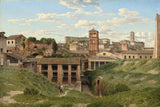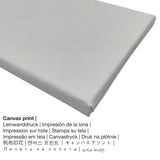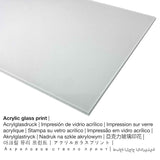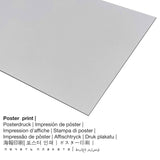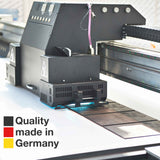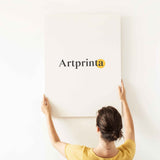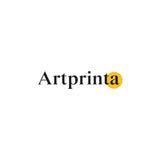Christoffer Wilhelm Eckersberg, 1814 - View of the Cloaca Maxima, Rome - fine art print
Tax included. Shipping calculated at checkout.
Original artwork specifications from the museum (© - by National Gallery of Art - www.nga.gov)
In 1803, at the age of 20, Christoffer Wilhelm Eckersberg went to Copenhagen to study at the Royal Dutch Academy of Fine Arts. After a sojourn in Paris, where he studied with Jacques-Louis David (1748–1825), and Rome, where he became part of a group of international artists engaged in the practice of plein air painting, he returned to the Royal Dutch Academy, first as professor and later director. Eckersberg is often referred to as the father of Danish painting for his influence on the generation of young artists who would come to be associated with the Golden Age of Danish painting during the first half of the 19th century.
Much of what we know about Eckersberg's working methods comes from the artist himself. In addition to the many letters he wrote from abroad, he authored two books on perspective and kept extensive personal diaries. During his stay in Rome, Eckersberg wrote of his work in a letter to his friend J. F. Clemens, "I intend to make a collection of the most beautiful of the many picturesque parts of Rome and the surrounding area. I have been working on them throughout the spring. I have already almost half a score of small sketches finished, all of which were completed on the spot after nature. I limit myself especially to architectural things." Painted in 1814, View of the Cloaca Maxima, Rome comes out of this experience of painting from direct observation. Although the artist himself refers to such paintings as sketches, the highly finished surface and meticulous brushwork of this painting suggests otherwise. Recent scientific examination has revealed extensive graphite drawing underneath the paint layer. Nevertheless, the painting conveys a feeling of immediacy, freshness, and sense of place typically associated with plein air practice.
Remarkable for its attention to detail and unusual viewpoint, the focus of View of the Cloaca Maxima, Rome seems to be on the architectural lines and their articulation of the pictoral space rather than on the famous buildings themselves. Landmarks are difficult to spot—the ancient Roman sewer system nestled beneath the hillsides in the center foreground, the Janus Arch to the left and the San Giorgio Church to the right in the middle ground, and the Campidoglio in the background. The tension created by Eckersberg's interest in linear perspective and nature study, a bridge of sorts between 18th- and 19th-century thought, is eased by the quiet Mediterranean light that bathes the scene.
Eckersberg exhibited this picture in 1828 as a pendant to his Panorama of Rome through Three Arches of the Colosseum (Statens Museum for Kunst, Copenhagen). Along with that famous work, View of the Cloaca Maxima, Rome is one of his true masterpieces of landscape painting.
Background data on the piece of art
| Painting name: | "View of the Cloaca Maxima, Rome" |
| Artwork categorization: | painting |
| General term: | modern art |
| Temporal classification: | 19th century |
| Created in: | 1814 |
| Approximate age of artwork: | 200 years old |
| Original medium of artwork: | oil on canvas |
| Dimensions of the original artpiece: | 31,8 x 47,4 cm |
| Exhibited in: | National Gallery of Art |
| Location of the museum: | Washington D.C., United States of America |
| Website: | National Gallery of Art |
| License type: | public domain |
| Courtesy of: | National Gallery of Art, Washington |
Artist details table
| Artist name: | Christoffer Wilhelm Eckersberg |
| Artist gender: | male |
| Artist nationality: | Danish |
| Jobs of the artist: | painter |
| Country of origin: | Denmark |
| Classification: | modern artist |
| Art styles: | Realism |
| Age at death: | 70 years |
| Born in the year: | 1783 |
| Place of birth: | Blaakrog, Varnaes, South Jutland, Denmark |
| Died: | 1853 |
| Town of death: | Copenhagen, Denmark |
The product specifications
| Article classification: | wall art |
| Reproduction method: | digital reproduction |
| Manufacturing process: | UV direct printing |
| Provenance: | German production |
| Type of stock: | production on demand |
| Proposed product use: | gallery wall, wall décor |
| Alignment: | landscape format |
| Aspect ratio: | length : width - 3 : 2 |
| Image aspect ratio meaning: | the length is 50% longer than the width |
| Available product fabrics: | canvas print, acrylic glass print (with real glass coating), poster print (canvas paper), metal print (aluminium dibond) |
| Canvas print (canvas on stretcher frame) size variants: | 30x20cm - 12x8", 60x40cm - 24x16", 90x60cm - 35x24", 120x80cm - 47x31", 150x100cm - 59x39" |
| Acrylic glass print (with real glass coating) size variants: | 30x20cm - 12x8", 60x40cm - 24x16", 90x60cm - 35x24", 120x80cm - 47x31", 150x100cm - 59x39" |
| Poster print (canvas paper): | 60x40cm - 24x16", 90x60cm - 35x24", 120x80cm - 47x31" |
| Aluminium dibond print (aluminium material): | 30x20cm - 12x8", 60x40cm - 24x16", 90x60cm - 35x24", 120x80cm - 47x31" |
| Frame: | no frame |
Select a material option
We offer a range of various sizes and materials for every product. Pick your favorite size and material among the following options:
- Canvas: A UV printed canvas stretched on a wood stretcher frame. The canvas creates a lively and pleasing look. The great advantage of canvas prints is that they are relatively low in weight, which implies that it is easy to hang up your Canvas print without extra wall-mounts. Hence, a canvas print is suited for any type of wall.
- Print on glossy acrylic glass (with real glass coating): An acrylic glass print, which is sometimes referred to as a plexiglass print, will transform the original artwork into brilliant décor. The artwork is manufactured with the help of modern UV printing technology. This makes vivid, impressive colors. The plexiglass protects your chosen art replica against sunlight and heat for many years.
- Aluminium dibond print: An Aluminium Dibond print is a material with an outstanding effect of depth. A non-reflective surface creates a modern impression. The bright & white sections of the work of art shimmer with a silky gloss, however without the glare. The colors of the print are bright and luminous, the details are crisp and clear.
- Poster on canvas material: The poster is a printed canvas with a slight surface structure. Please note, that depending on the absolute size of the canvas poster print we add a white margin of approximately 2-6cm round about the print to facilitate the framing with your custom frame.
The art product
This modern art artpiece was painted by the realist master Christoffer Wilhelm Eckersberg in 1814. The painting was made with the size: 31,8 x 47,4 cm. Oil on canvas was used by the artist as the medium of the painting. Moveover, the artpiece is in the the collection of National Gallery of Art, which is the museum of the US-American nation that preserves, collects, exhibits, and fosters an understanding of works of art. With courtesy of National Gallery of Art, Washington (public domain license).: . Further, the alignment of the digital reproduction is landscape with a ratio of 3 : 2, meaning that the length is 50% longer than the width. The painter Christoffer Wilhelm Eckersberg was an artist from Denmark, whose style can primarily be classified as Realism. The painter was born in 1783 in Blaakrog, Varnaes, South Jutland, Denmark and deceased at the age of 70 in 1853.
Important note: We try in order to describe the products as accurately as possible and to showcase them visually. Nevertheless, the pigments of the printing material and the printing might differ to a certain extent from the representation on your device's screen. Depending on your settings of your screen and the quality of the surface, color pigments might not be printed as realisitcally as the digital version. Considering that all art reproductions are printed and processed manually, there might as well be minor deviations in the motif's size and exact position.
© Copyright of | www.artprinta.com (Artprinta)

